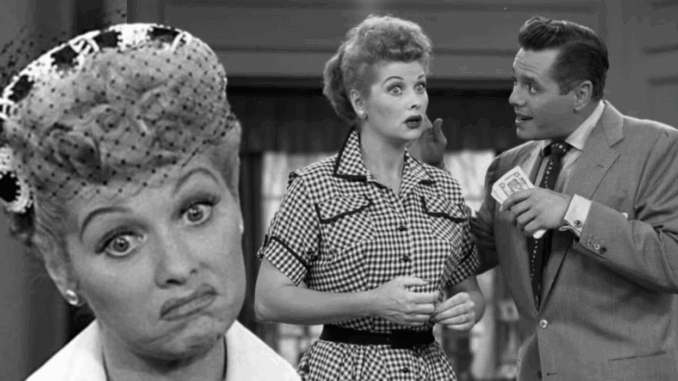
The Echo of a Golden Age: How I Love Lucy’s Laughter Lived on Long After Its Run
For many, the unmistakable sound of a live studio audience’s laughter is the defining feature of a classic sitcom. It’s the punctuation mark after a perfectly delivered punchline, the sonic shorthand for shared joy and communal entertainment. And for decades, the gold standard for that sound was the roaring, genuine laughter of the audience that filled the Desilu Playhouse to watch I Love Lucy.
But what many fans don’t know is that the laughter you hear on countless other shows from that era and beyond might not be as spontaneous as you think. In a fascinating and little-known chapter of television history, CBS, the network that aired I Love Lucy, actually reused and repurposed the show’s live laughter for other series, creating an echoing legacy of joy that lasted for years.
The Problem with the Laugh Track
When I Love Lucy premiered, the use of a laugh track was already common in television. These pre-recorded laughter sounds were used to simulate an audience reaction for shows filmed without one, or to enhance the laughter of a live studio audience. But the laugh tracks of the time were often flat, synthetic, and unconvincing. They sounded canned, and audiences could tell.
Lucille Ball and Desi Arnaz had a different vision. They wanted their show to feel as organic and as real as a live stage performance. They made the revolutionary decision to film their show on a sound stage with a live studio audience, using a three-camera system developed by Desi Arnaz and cinematographer Karl Freund. This was a massive undertaking, but it paid off. The show’s humor was elevated by the genuine, immediate reactions of the people in the room. The sound of their unadulterated laughter became part of the show’s DNA.
However, a new problem arose: what to do with all that high-quality, genuine laughter?
The Birth of a Reusable Sound Library
Desi Arnaz, ever the shrewd businessman, realized that the live laughter they were recording was a valuable asset. Unlike the generic laugh tracks of the day, their recordings were rich, dynamic, and full of natural variations—they were the real deal.
The sound mixers for I Love Lucy created a meticulous and highly organized library of these audience reactions. They cataloged everything: a quiet chuckle, a single loud laugh, a group of people tittering, and the massive, explosive guffaws that followed some of the show’s most iconic gags. This library was a gold mine. It was a perfect, real-life laugh track, and CBS wasn’t about to let it go to waste.
Network executives at the time faced a constant challenge: how to make shows filmed in different formats—some with live audiences, some without—all sound as if they had the same kind of audience engagement. The answer was right there in the sound vaults.
CBS began to use the laughs from I Love Lucy to sweeten other shows’ laugh tracks. They would add bits and pieces of the meticulously organized laughter library to shows that were filmed without an audience, giving them a more “live” feel. This was not a secret. It was a widely-known practice within the television industry, but it was rarely talked about outside of it.
The Legacy of the Laugh Track
The most fascinating part of this story is that the practice of reusing laughter was not limited to just a few shows. The echoes of the I Love Lucy audience could be heard on a wide variety of television programs, from other sitcoms to variety shows and even game shows. The sound of that genuine, 1950s laughter became the unofficial soundtrack for an entire era of television.
This practice also had a profound impact on the development of the laugh track itself. While Arnaz and Freund had pioneered a way to capture genuine laughter, many other producers chose to use the canned laughs to save on the cost of a live audience. The problem was that these laugh tracks were often used so indiscriminately that they became a joke themselves. They were inserted in inappropriate places, or they sounded too loud and artificial, making the viewer feel like they were being told when to laugh.
The legacy of I Love Lucy‘s laughter is a complex one. On one hand, it’s a brilliant example of a studio and a network leveraging a valuable asset. The sound library was a testament to the high-quality production of I Love Lucy and the business acumen of Desi Arnaz. On the other hand, it’s a bittersweet reminder that the authenticity of live television was slowly being replaced by the manufactured reality of the laugh track.
Today, the laugh track is a rare sight in modern television, with most comedies opting for single-camera filming and no audience reaction at all. The move away from the laugh track is a direct response to a cultural shift in how we consume comedy. We no longer need to be told when to laugh.
But the next time you watch a classic sitcom from the 1960s or 70s, listen closely. You might just hear a familiar sound. It could be the echo of a joke from the past, a ripple of a real laugh from a long-gone audience. It’s the sound of a genuine moment of comedy, captured by the brilliant minds behind I Love Lucy, and reused for decades to come, ensuring that the legacy of one of television’s greatest shows would be heard far and wide, one laugh at a time.
